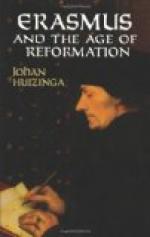A picture of the interruptions to which Erasmus was exposed is given in a preface written in Froben’s name for the new edition of Erasmus’ Epigrammata combined with More’s and with the Utopia, March 1518. ‘Most of these verses’ Froben is made to say ’were written not for publication, but to give pleasure to friends; to whom he is always very obliging. When he was here bringing out his New Testament and Jerome, heavens! how he worked! toiling away untiringly day after day. Never was any one more overwhelmed in composition; and yet certain great persons thought themselves entitled to come and waste his time, coaxing out of him a few lines of verse or a little letter. So compliant was he that they made it very difficult for him. To refuse seemed uncivil when they pressed him so. But to write when his mind was intent elsewhere, and not a minute to spare from his labours——! However, he did write, on the spur of the moment, turning aside for a little to the groves of the Muses.’
Some other visitors can be traced in this period. John Alexander Brassicanus, poet laureate, came from Tubingen in September 1520 and saw Erasmus at Antwerp; whence in reply to a letter of self-introduction he bore away a complimentary letter that he afterwards printed, and the sound piece of advice, that if he wished to become learned, he must never think himself so. More distinguished was Ferdinand Columbus, the explorer’s natural son and heir, who in October 1520, on one of those journeys on which he gathered his famous library, received at Louvain a copy of Erasmus’ Antibarbari, with his name inscribed in it by the author. A visitor to whom we must pay more heed was John Draco, one of the Erfurt circle, who in July 1520 came to pay homage at Louvain.




